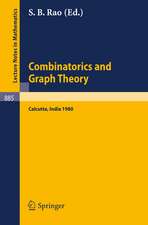An Introduction to Enumeration: Springer Undergraduate Mathematics Series
Autor Alan Camina, Barry Lewisen Limba Engleză Paperback – 18 mai 2011
Written for students taking a second or third year undergraduate course in mathematics or computer science, this book is the ideal companion to a course in enumeration. Enumeration is a branch of combinatorics where the fundamental subject matter is numerous methods of pattern formation and counting. Introduction to Enumeration provides a comprehensive and practical introduction to this subject giving a clear account of fundamental results and a thorough grounding in the use of powerful techniques and tools.
Two major themes run in parallel through the book, generating functions and group theory. The former theme takes enumerative sequences and then uses analytic tools to discover how they are made up. Group theory provides a concise introduction to groups and illustrates how the theory can be used to count the number of symmetries a particular object has. These enrich and extend basic group ideas and techniques.
The authors present their material through examples that are carefully chosen to establish key results in a natural setting. The aim is to progressively build fundamental theorems and techniques. This development is interspersed with exercises that consolidate ideas and build confidence. Some exercises are linked to particular sections while others range across a complete chapter. Throughout, there is an attempt to present key enumerative ideas in a graphic way, using diagrams to make them immediately accessible. The development assumes some basic group theory, a familiarity with analytic functions and their power series expansion along with some basic linear algebra.
Din seria Springer Undergraduate Mathematics Series
-
 Preț: 350.50 lei
Preț: 350.50 lei -
 Preț: 237.41 lei
Preț: 237.41 lei -
 Preț: 358.82 lei
Preț: 358.82 lei -
 Preț: 237.18 lei
Preț: 237.18 lei -
 Preț: 240.63 lei
Preț: 240.63 lei -
 Preț: 268.37 lei
Preț: 268.37 lei -
 Preț: 224.54 lei
Preț: 224.54 lei -
 Preț: 319.90 lei
Preț: 319.90 lei -
 Preț: 301.10 lei
Preț: 301.10 lei -
 Preț: 236.97 lei
Preț: 236.97 lei -
 Preț: 358.55 lei
Preț: 358.55 lei -
 Preț: 325.20 lei
Preț: 325.20 lei -
 Preț: 221.92 lei
Preț: 221.92 lei -
 Preț: 237.29 lei
Preț: 237.29 lei -
 Preț: 359.15 lei
Preț: 359.15 lei -
 Preț: 265.92 lei
Preț: 265.92 lei -
 Preț: 236.87 lei
Preț: 236.87 lei -
 Preț: 383.17 lei
Preț: 383.17 lei -
 Preț: 229.86 lei
Preț: 229.86 lei -
 Preț: 238.28 lei
Preț: 238.28 lei -
 Preț: 283.11 lei
Preț: 283.11 lei -
 Preț: 239.86 lei
Preț: 239.86 lei -
 Preț: 266.70 lei
Preț: 266.70 lei -
 Preț: 269.99 lei
Preț: 269.99 lei - 15%
 Preț: 526.67 lei
Preț: 526.67 lei -
 Preț: 272.49 lei
Preț: 272.49 lei -
 Preț: 320.20 lei
Preț: 320.20 lei -
 Preț: 265.18 lei
Preț: 265.18 lei -
 Preț: 275.36 lei
Preț: 275.36 lei -
 Preț: 278.24 lei
Preț: 278.24 lei -
 Preț: 272.69 lei
Preț: 272.69 lei -
 Preț: 258.88 lei
Preț: 258.88 lei -
 Preț: 265.83 lei
Preț: 265.83 lei -
 Preț: 275.74 lei
Preț: 275.74 lei -
 Preț: 328.08 lei
Preț: 328.08 lei -
 Preț: 265.78 lei
Preț: 265.78 lei -
 Preț: 275.74 lei
Preț: 275.74 lei -
 Preț: 273.45 lei
Preț: 273.45 lei -
 Preț: 277.32 lei
Preț: 277.32 lei -
 Preț: 270.57 lei
Preț: 270.57 lei -
 Preț: 273.63 lei
Preț: 273.63 lei -
 Preț: 270.19 lei
Preț: 270.19 lei -
 Preț: 265.36 lei
Preț: 265.36 lei -
 Preț: 265.36 lei
Preț: 265.36 lei -
 Preț: 268.08 lei
Preț: 268.08 lei -
 Preț: 272.86 lei
Preț: 272.86 lei -
 Preț: 272.69 lei
Preț: 272.69 lei -
 Preț: 271.16 lei
Preț: 271.16 lei -
 Preț: 270.74 lei
Preț: 270.74 lei
Preț: 266.70 lei
Nou
Puncte Express: 400
Preț estimativ în valută:
51.04€ • 53.09$ • 42.14£
51.04€ • 53.09$ • 42.14£
Carte tipărită la comandă
Livrare economică 14-28 aprilie
Preluare comenzi: 021 569.72.76
Specificații
ISBN-13: 9780857295996
ISBN-10: 0857295993
Pagini: 235
Ilustrații: XII, 232 p. 62 illus.
Dimensiuni: 155 x 235 x 18 mm
Greutate: 0.34 kg
Ediția:2011
Editura: SPRINGER LONDON
Colecția Springer
Seria Springer Undergraduate Mathematics Series
Locul publicării:London, United Kingdom
ISBN-10: 0857295993
Pagini: 235
Ilustrații: XII, 232 p. 62 illus.
Dimensiuni: 155 x 235 x 18 mm
Greutate: 0.34 kg
Ediția:2011
Editura: SPRINGER LONDON
Colecția Springer
Seria Springer Undergraduate Mathematics Series
Locul publicării:London, United Kingdom
Public țintă
Upper undergraduateCuprins
What Is Enumeration?.- Generating Functions Count.- Working with Generating Functions.- Permutation Groups.- Matrices, Sequences and Sums.- Group Actions and Counting.- Exponential Generating Functions.- Graphs.- partitions and Paths.
Recenzii
From the reviews:
“This work is a very basic, short introduction to combinatorial enumeration techniques. Camina (Univ. of East Anglia, UK) and Lewis (The Mathematical Association, UK) properly explain the fundamental concepts … . There are 20-25 exercises per chapter … . The numerical answers to the majority of these exercises are included at the end. … It may be useful for students who need very basic enumeration skills … . Summing Up … . Lower- and upper-division undergraduates.” (M. Bona, Choice, Vol. 49 (4), December, 2011)
“This book is written as an introduction to enumeration for second or third year undergraduate students in mathematics or computer science. Its theme is counting, using finite or infinite series … . The development is interspersed with exercises, linked to particular sections, or covering a complete chapter. Solutions are provided at the end of the book.” (Andreas N. Philippou, Zentralblatt MATH, Vol. 1230, 2012)
“This is an introductory text on counting and combinatorics that has good coverage … . It is aimed at a sophomore or higher level and has few prerequisites beyond power series. … There are numerous exercises, and all have brief solutions in the back. … It is unusual to see a book that combines such extensive coverage with so few prerequisites.” (Allen Stenger, The Mathematical Association of America, August, 2011)
“This work is a very basic, short introduction to combinatorial enumeration techniques. Camina (Univ. of East Anglia, UK) and Lewis (The Mathematical Association, UK) properly explain the fundamental concepts … . There are 20-25 exercises per chapter … . The numerical answers to the majority of these exercises are included at the end. … It may be useful for students who need very basic enumeration skills … . Summing Up … . Lower- and upper-division undergraduates.” (M. Bona, Choice, Vol. 49 (4), December, 2011)
“This book is written as an introduction to enumeration for second or third year undergraduate students in mathematics or computer science. Its theme is counting, using finite or infinite series … . The development is interspersed with exercises, linked to particular sections, or covering a complete chapter. Solutions are provided at the end of the book.” (Andreas N. Philippou, Zentralblatt MATH, Vol. 1230, 2012)
“This is an introductory text on counting and combinatorics that has good coverage … . It is aimed at a sophomore or higher level and has few prerequisites beyond power series. … There are numerous exercises, and all have brief solutions in the back. … It is unusual to see a book that combines such extensive coverage with so few prerequisites.” (Allen Stenger, The Mathematical Association of America, August, 2011)
Notă biografică
"I have adopted your text "An introduction to enumeration" for my
undergraduate combinatorics course. Overall, it is wonderful...I like how your book actually teaches something, beyond a loose tour of combinatorics that many other books offer. The ability to fluidly go back and forth between recurrences and generating functions, that sort of thing...It trades the broadest focus for specific techniques, in that way reminding me what's fun in say, an ODE course. My students actually learn something they couldn't do before, it makes them feel smart so they like the course " (Prof Dave Bayer, Barnard College, NY, USA)
undergraduate combinatorics course. Overall, it is wonderful...I like how your book actually teaches something, beyond a loose tour of combinatorics that many other books offer. The ability to fluidly go back and forth between recurrences and generating functions, that sort of thing...It trades the broadest focus for specific techniques, in that way reminding me what's fun in say, an ODE course. My students actually learn something they couldn't do before, it makes them feel smart so they like the course " (Prof Dave Bayer, Barnard College, NY, USA)
Textul de pe ultima copertă
Written for students taking a second or third year undergraduate course in mathematics or computer science, this book is the ideal companion to a course in enumeration. Enumeration is a branch of combinatorics where the fundamental subject matter is numerous methods of pattern formation and counting. An Introduction to Enumeration provides a comprehensive and practical introduction to this subject giving a clear account of fundamental results and a thorough grounding in the use of powerful techniques and tools.
Two major themes run in parallel through the book, generating functions and group theory. The former theme takes enumerative sequences and then uses analytic tools to discover how they are made up. Group theory provides a concise introduction to groups and illustrates how the theory can be used to count the number of symmetries a particular object has. These enrich and extend basic group ideas and techniques.
The authors present their material through examples that are carefully chosen to establish key results in a natural setting. The aim is to progressively build fundamental theorems and techniques. This development is interspersed with exercises that consolidate ideas and build confidence. Some exercises are linked to particular sections while others range across a complete chapter. Throughout, there is an attempt to present key enumerative ideas in a graphic way, using diagrams to make them immediately accessible. The development assumes some basic group theory, a familiarity with analytic functions and their power series expansion along with some basic linear algebra.
Two major themes run in parallel through the book, generating functions and group theory. The former theme takes enumerative sequences and then uses analytic tools to discover how they are made up. Group theory provides a concise introduction to groups and illustrates how the theory can be used to count the number of symmetries a particular object has. These enrich and extend basic group ideas and techniques.
The authors present their material through examples that are carefully chosen to establish key results in a natural setting. The aim is to progressively build fundamental theorems and techniques. This development is interspersed with exercises that consolidate ideas and build confidence. Some exercises are linked to particular sections while others range across a complete chapter. Throughout, there is an attempt to present key enumerative ideas in a graphic way, using diagrams to make them immediately accessible. The development assumes some basic group theory, a familiarity with analytic functions and their power series expansion along with some basic linear algebra.
Caracteristici
Includes over 350 worked examples and over 200 exercises with solutions Focuses on the application of major mathematical topics including linear algebra, group theory and complex analysis Strong emphasis on generating functions Includes supplementary material: sn.pub/extras



















